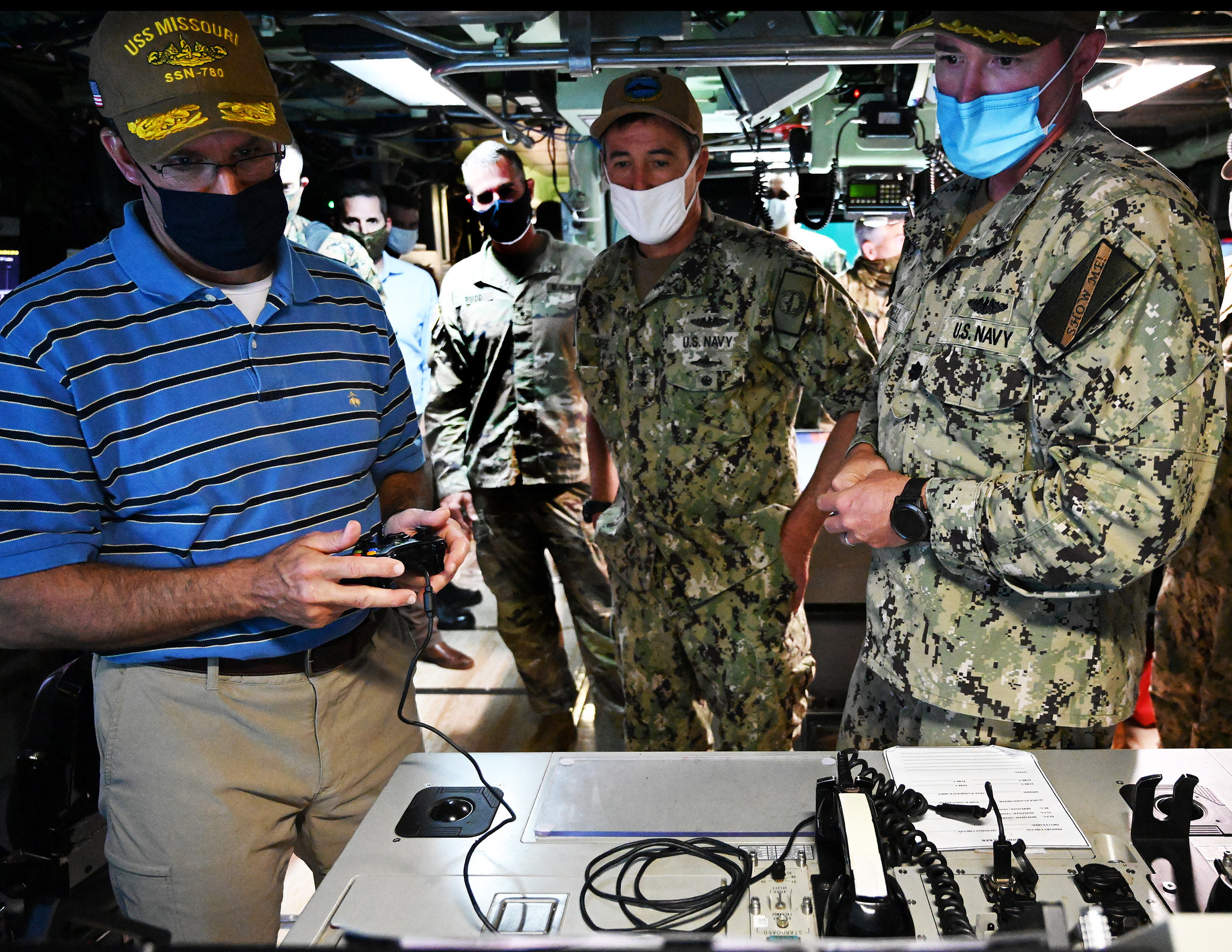
Cmdr. George Howell, right, commanding officer of USS Missouri submarine, shows Defense Secretary Mark Esper the Missouri’s control room.
Clarification: The story included Esper’s prepared remarks calling for the Navy’s shipbuilding account to grow from 11% to 13% of the service’s budget. His delivered remarks omitted those numbers. A DoD spokesman said that growth target is “predecisional” and was struck before the speech. The story has been updated.
WASHINGTON: Defense Secretary Mark Esper today called for growing the Navy’s shipbuilding budget to stay ahead of the Chinese shipbuilding boom, a promise that could pressure other parts of the service’s budget.
The secretary’s comments today at the RAND think tank in San Diego reflect the dilemma the Navy will face in the coming years as defense budgets stay flat, but the service embarks on a variety of new shipbuilding efforts including the Columbia class of submarines, the service’s highest priority.
Esper said the Pentagon “must increase funding for shipbuilding and the readiness that sustains a larger force. Doing this, and finding the money within the Navy budget and elsewhere to make it real, is something both the Navy leadership and I are committed to doing.””
Looking closely at what the secretary outlined suggests he is not advocating a larger Navy budget, but a larger shipbuilding line within the existing Navy budget.
“He’s not saying give the Navy more money. He’s saying the Navy needs to spend more on shipbuilding,” said Bryan Clark, a naval analyst at the Hudson Institute.
Where will they find that much money? Probably personnel and operations and maintenance accounts, but they are problematic in their own right. The Navy is already struggling with crewing all of its ships and having enough sailors ashore to perform logistics and other duties, and O&M accounts have already been squeezed in order to spend more on research and development for things like unmanned ships.
One way to flow more cash into new ships without pulling from other Navy accounts would be to use the National Sea-Based Deterrence Fund created by Congress in 2014 to fund part of the Columbia-class submarine program, which is going to take up over 30 percent of the Navy’s yearly shipbuilding budget between 2026 and 2030.
“They could [pull from that account] tomorrow,” Rep. Joe Courtney, chairman of the House’s Seapower and Projection Forces Subcommittee, told me by phone today.
“We’ve been making that case to CNO and actually, we had a meeting with Undersecretary of Defense David Norquist pointing out the fact that they have the tools to do that, and it accomplishes exactly the goal that he’s talking about, which is every dollar of unobligated funds from other parts of the Pentagon’s budget that gets deposited in the Columbia program is a dollar that you’re freeing up for non-Columbia shipbuilding,” Courtney said.
The bill for Columbia is “just gonna be huge. Sucking up ship dollars…at least the next 15 to 20 years as the program gets built,” he added. “It would have the same effect of increasing the shipbuilding share of the Pentagon’s budget. It’s not the only way that you get to 13% but it certainly accomplishes the budget flexibility that he sees is necessary.”
Esper said he had been briefed earlier this week on the new Navy force structure plan, which lays out a path toward building a fleet of more than 355 ships of manned and unmanned vessels, many of which will be smaller than the destroyers and super carriers that make up the fleet today.
Like Esper, Navy Secretary Kenneth Braithwaite has said that he thinks the Navy’s previous goal of 355 ships is too low. Navy spokesman Capt. Jereal Dorsey told me today that Braithwaite “believes 355 ships are the minimum to which the Department of the Navy should be aiming,” and he has been “working closely with Secretary Esper and [Deputy Defense Secretary] Norquist on the Future Naval Force Study to identify how best to achieve this objective. He looks forward to continuing working with Secretary Esper, Adm. Gilday, and Gen Berger on building future budgets that can achieve this goal realistically.”
Clark and his team at Hudson advised the Pentagon on the future force study, and he said one of its findings was that O&M could be curtailed if the proposed new classes of ships are smaller, making them cheaper to maintain. In addition to small, medium and large unmanned platforms, the Navy is also considering a new Corvette and has already signed a contract to build at least nine new frigates.
But those proposed changes are years in the future. The frigate and unmanned ships won’t see duty until late this decade or early next, making any O&M savings years away. But lawmakers and the Pentagon want to start the process now.
The call for heightened spending will find some powerful advocates on Capitol Hill, where some lawmakers have long called for the Navy to grow significantly.
“It is clear that our attention must be on the Pacific and our shipbuilding budget needs to reflect that, lest we be outpaced and outmatched by China,” Rep. Rob Wittman, ranking member of the Seapower and Projection Forces Subcommittee emailed today. “I enthusiastically endorse this notion and look forward to Secretary Esper matching this shared sentiment in the 30-year shipbuilding plan and DoD’s FY22 budget request.”
Multi-ship amphib buy could net $900M in savings, say Navy, Marine Corps officials
Lawmakers gave the Navy authorities to ink a multi-ship amphib deal years ago, but the service has not utilized that power yet.


























